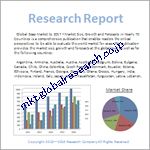目次
第1章.世界の心不全POCおよびLOCデバイス市場 エグゼクティブサマリー
1.1.心不全POCおよびLOCデバイスの世界市場規模・予測(2022~2032年)
1.2.地域別概要
1.3.セグメント別概要
1.3.1.タイプ別
1.3.2.技術別
1.3.3.最終用途別
1.4.主要動向
1.5.不況の影響
1.6.アナリストの提言と結論
第2章 心不全POCおよびLOCデバイスの世界市場世界の心不全POCおよびLOCデバイス市場の定義と調査前提
2.1.調査目的
2.2.市場の定義
2.3.調査の前提
2.3.1.包含と除外
2.3.2.限界
2.3.3.供給サイドの分析
2.3.3.1.入手可能性
2.3.3.2.インフラ
2.3.3.3.規制環境
2.3.3.4.市場競争
2.3.3.5.経済性(消費者の視点)
2.3.4.需要サイド分析
2.3.4.1.規制の枠組み
2.3.4.2.技術の進歩
2.3.4.3.環境への配慮
2.3.4.4.消費者の意識と受容
2.4.推定方法
2.5.調査対象年
2.6.通貨換算レート
第3章.心不全POCおよびLOCデバイスの世界市場ダイナミクス
3.1.市場促進要因
3.1.1.世界的な心血管疾患の有病率の上昇
3.1.2.POCおよびLOC診断の技術的進歩
3.1.3.分散型ヘルスケアソリューションの採用拡大
3.2.市場の課題
3.2.1.多項目診断に対する明確な償還枠組みの欠如
3.2.2.高度な診断機器の高コスト
3.3.市場機会
3.3.1.LOCベース技術への研究開発投資の増加
3.3.2.個別化医療と早期診断に対する需要の高まり
3.3.3.新興国における医療インフラの拡大
第4章.世界の心不全POCおよびLOCデバイス市場産業分析
4.1.ポーターの5フォースモデル
4.1.1.サプライヤーの交渉力
4.1.2.バイヤーの交渉力
4.1.3.新規参入者の脅威
4.1.4.代替品の脅威
4.1.5.競合他社との競争
4.2.PESTEL分析
4.2.1.政治的
4.2.2.経済
4.2.3.社会
4.2.4.技術
4.2.5.環境
4.2.6.法律
4.3.トップの投資機会
4.4.トップ勝ち組戦略
4.5.破壊的トレンド
4.6.業界専門家の視点
4.7.アナリストの推奨と結論
第5章.心不全POCおよびLOCデバイスの世界市場規模・タイプ別予測(2022〜2032年)
5.1.セグメントダッシュボード
5.2.心不全POCおよびLOCデバイスの世界市場タイプ別収益動向分析、2022年および2032年(百万米ドル)
5.2.1.プロテオーム検査
5.2.2.メタボローム検査
5.2.3.ゲノム検査
第6章.心不全POCおよびLOCデバイスの世界市場規模・技術別予測(2022~2032年)
6.1.セグメントダッシュボード
6.2.心不全POCおよびLOCデバイスの世界市場技術別収益動向分析、2022年および2032年(百万米ドル)
6.2.1.マイクロフルイディクス
6.2.2.アレイベースのシステム
6.2.3.その他
第7章.心不全POCおよびLOCデバイスの世界市場規模・用途別予測(2022~2032年)
7.1.セグメントダッシュボード
7.2.心不全POCおよびLOCデバイスの世界市場最終用途別売上高動向分析、2022年および2032年 (百万米ドル)
7.2.1.診療所
7.2.2.病院
7.2.3.自宅
7.2.4.介護付き医療施設
7.2.5.研究室
第8章.心不全POCおよびLOCデバイスの世界地域別市場規模・予測(2022〜2032年)
8.1.北米の心不全POCおよびLOCデバイス市場
8.1.1.米国の心不全POCおよびLOCデバイス市場
8.1.2.カナダの心不全POCおよびLOCデバイス市場
8.1.3.メキシコの心不全POCおよびLOCデバイス市場
8.2.欧州の心不全POCおよびLOCデバイス市場
8.2.1.イギリスの心不全POCおよびLOCデバイス市場
8.2.2.ドイツの心不全POCおよびLOCデバイス市場
8.2.3.フランスの心不全POCおよびLOCデバイス市場
8.2.4.イタリアの心不全POCおよびLOCデバイス市場
8.2.5.スペイン心不全POCおよびLOCデバイス市場
8.2.6.デンマーク心不全POCおよびLOCデバイス市場
8.2.7.スウェーデンの心不全POCおよびLOCデバイス市場
8.2.8.ノルウェー心不全POCおよびLOCデバイス市場
8.3.アジア太平洋地域の心不全POCおよびLOCデバイス市場
8.3.1.日本の心不全POCおよびLOCデバイス市場
8.3.2.中国の心不全POCおよびLOCデバイス市場
8.3.3.インドの心不全POCおよびLOCデバイス市場
8.3.4.オーストラリアの心不全POCおよびLOCデバイス市場
8.3.5.タイの心不全POCとLOCデバイス市場
8.3.6.韓国の心不全POCおよびLOCデバイス市場
8.4.中南米の心不全POCおよびLOCデバイス市場
8.4.1.ブラジルの心不全POCおよびLOCデバイス市場
8.4.2.アルゼンチン心不全POCおよびLOCデバイス市場
8.5.中東・アフリカの心不全POCおよびLOCデバイス市場
8.5.1.サウジアラビアの心不全POCとLOCデバイス市場
8.5.2.UAEの心不全POCおよびLOCデバイス市場
8.5.3.南アフリカの心不全POCとLOCデバイス市場
8.5.4.クウェートの心不全POCおよびLOCデバイス市場
第9章 競争力競合他社の動向
9.1.主要企業のSWOT分析
9.1.1.アボット
9.1.2.ダナハー
9.1.3.シーメンス・ヘルティニアーズ
9.2.トップ市場戦略
9.3.企業プロフィール
9.3.1.エフ・ホフマン・ラ・ロシュ社
9.3.2.クィデル・コーポレーション
バイオメリューS.A.
9.3.4.トリニティー・バイオテック
9.3.5.アバクシス
9.3.6.フィリップスヘルスケア
9.3.7.バイオ・ラッド・ラボラトリーズ
9.3.8.ナノダックス社
9.3.9.オルソ・クリニカル・ダイアグノスティックス
9.3.10.特定診断薬
第10章 研究プロセス研究プロセス
10.1.研究プロセス
10.1.1.データマイニング
10.1.2.分析
10.1.3.市場推定
10.1.4.バリデーション
10.1.5.出版
10.2.研究属性
図表一覧
1.心不全POCおよびLOCデバイスの世界市場タイプ別予測(2022-2032年)
2.心不全POCおよびLOCデバイスの世界市場:技術別予測(2022-2032年)
3.心不全POCおよびLOCデバイスの世界市場:用途別予測(2022-2032年)
4.心不全POCおよびLOCデバイスの世界市場地域別分析(2022-2032年)
5.米国の心不全POCおよびLOCデバイス市場規模・予測:タイプ別(2022-2032年
6.ドイツ心不全POCおよびLOCデバイス市場規模・予測:技術別、2022-2032年
7.日本の心不全POCおよびLOCデバイス市場規模・予測:エンドユース別、2022-2032年
8.北米の心不全POCおよびLOCデバイス市場:タイプ別収益(2022-2032年)
9.欧州の心不全POCおよびLOCデバイス市場:技術別収益(2022-2032年)
10.アジア太平洋地域の心不全POCおよびLOCデバイス市場:用途別収益(2022-2032年)
11.ブラジル心不全POCおよびLOCデバイス市場予測:タイプ別(2022-2032年
12.中東の心不全POCおよびLOCデバイス市場分析:技術別(2022-2032年
13.プロテオーム検査の世界市場規模、2022-2032年(百万米ドル)
14.メタボローム検査の世界市場規模、2022-2032年(百万米ドル)
15.ゲノム検査の世界市場規模、2022-2032年(USD Million)
16.マイクロ流体技術の採用動向(2024-2032年)
17.アレイベースシステムの地域別売上シェア(2022-2032年)
18.心不全診断における在宅検査機器市場の成長(2022-2032年)
19.地域別心不全発生率(年齢層別)(2022-2032年
20.心不全POCデバイスの病院・診療所売上シェア(2022~2032年)
21.世界の心不全POC・LOCデバイス市場の競合環境分析(2024年)
22.地域ごとのPOCおよびLOCデバイスの規制枠組み
23.マイクロ流体ベースの心不全診断への投資(2024-2032年
24.個別化心不全管理ソリューションの新たな動向
25.NT-proBNP検査とトロポニンマーカーの感度比較
最終報告書には100以上の表が含まれる。このリストは最終報告書で更新される可能性がある。
図のリスト
1.心不全POCおよびLOCデバイスの世界市場規模、2022-2032年(百万米ドル)
2.セグメント別世界市場成長率(2024-2032年)
3.心不全POCおよびLOCデバイス市場:主要動向とダイナミクス(2024年
4.心不全診断におけるプロテオーム検査市場シェア(2024年
5.メタボローム検査市場の成長軌道、2022年~2032年
6.心血管アプリケーションにおけるゲノム検査動向、2022-2032年
7.主要地域におけるマイクロ流体技術の採用、2022-2032年
8.アレイベースシステム:地域別売上高比較、2024年
9.臨床現場におけるポイントオブケア検査機器の普及、2022-2032年
10.地域別インサイト心不全POCおよびLOCデバイスの普及、2024年
11.米国の心不全POCおよびLOCデバイス市場動向、2022-2032年
12.ドイツクリニックと在宅医療におけるLOCプラットフォームの採用(2024年
13.心不全診断のアジア太平洋市場成長促進要因、2022-2032年
14.技術比較:マイクロフルイディクスとアレイベースシステムの比較(2024年
15.NT-proBNP検査:採用率と成長率、2024-2032年
16.クリニック vs. 家庭用:エンドユースセグメントにおける市場シェア、2022年~2032年
17.循環器疾患の地域別有病率、2022-2032年
18.心不全診断薬への投資動向(地域別):2022-2032年
19.世界の高齢化人口増加と心不全発生率(2022-2032年
20.心不全の在宅検査機器の普及、2022〜2032年
21.LOCおよびPOC検査の精度向上におけるAIとデジタルヘルスの役割
22.主要市場プレイヤーの戦略的取り組み(2022~2032年
23.心不全診断における主要企業の競争ポジショニング
24.心血管診断におけるラボオンチップ技術の進化
25.市場成長に対する政府のイニシアティブの寄与(2024年
最終報告書には50以上の図表が含まれる。リストは最終成果物で更新される可能性があります。
The prevalence of diabetes and cardiovascular diseases has emerged as a major driver for the adoption of point-of-care (POC) diagnostics. For example, approximately 30% of diabetic patients develop heart failure, highlighting the urgent need for accessible and effective diagnostic tools. Innovations such as Roche Diagnostics' NT-proBNP test for early detection of heart failure in type 2 diabetes (T2D) patients are transforming preventive care. By enabling early intervention, these solutions improve clinical outcomes and reduce hospital admissions, particularly in resource-constrained settings.
Technological advancements, such as microfluidics-based LOC systems, allow precise handling of small biological samples for detecting key biomarkers like NT-proBNP, Troponin I, and Troponin T, which are critical for heart failure diagnosis. The integration of these technologies with artificial intelligence (AI) further enhances their accuracy and efficiency. For instance, algorithms like CoDe-ACS combine patient data and metrics to predict cardiac risks, accelerating the decision-making process.
Regionally, North America dominates the market due to its advanced healthcare infrastructure, strong R&D investments, and increasing adoption of POC diagnostics in clinical and homecare settings. The Asia Pacific region, however, is projected to grow at the fastest rate, driven by rising healthcare awareness, the prevalence of chronic diseases, and ongoing investments in medical infrastructure.
Despite the promising growth, challenges such as undefined reimbursement frameworks for multi-analyte devices and adoption barriers in emerging economies remain significant hurdles. Nevertheless, ongoing innovations and government initiatives, like the KardiaTool project in Europe, aim to address these issues and expand access to affordable diagnostic technologies.
Major Market Players Included in this Report Are:
1. Abbott
2. Danaher
3. Siemens Healthineers
4. F. Hoffmann-La Roche Ltd
5. Quidel Corporation
6. bioMérieux S.A
7. Trinity Biotech
8. Abaxis, Inc
9. Philips Healthcare
10. Ultromics
11. Bio-Rad Laboratories
12. NanoDx, Inc.
13. Randox Laboratories
14. Ortho Clinical Diagnostics
15. Specific Diagnostics
The Detailed Segments and Sub-segments of the Market Are Explained Below:
By Type:
• Proteomic Testing
• Metabolomic Testing
• Genomic Testing
By Technology:
• Microfluidics
• Array-based Systems
• Others
By End-use:
• Clinics
• Hospitals
• Home
• Assisted Living Healthcare Facilities
• Laboratory
By Region:
North America
• U.S.
• Canada
• Mexico
Europe
• UK
• Germany
• France
• Italy
• Spain
• Denmark
• Sweden
• Norway
Asia Pacific
• Japan
• China
• India
• Australia
• Thailand
• South Korea
Latin America
• Brazil
• Argentina
Middle East & Africa
• Saudi Arabia
• UAE
• South Africa
• Kuwait
Years Considered for the Study Are as Follows:
• Historical Year – 2022
• Base Year – 2023
• Forecast Period – 2024 to 2032
Key Takeaways:
• Market Estimates & Forecast for 10 Years (2022-2032).
• Annualized Revenue and Regional Analysis for Each Market Segment.
• Comprehensive Geographical Landscape Analysis with Country-level Details.
• Competitive Landscape with Market Share Analysis and Key Player Profiles.
• Detailed Business Strategies and Recommendations for Future Market Approach.
• Demand-side and Supply-side Analysis of the Market.
• Analysis of Technological Advancements and Emerging Trends.
❖ 免責事項 ❖
http://www.globalresearch.jp/disclaimer

